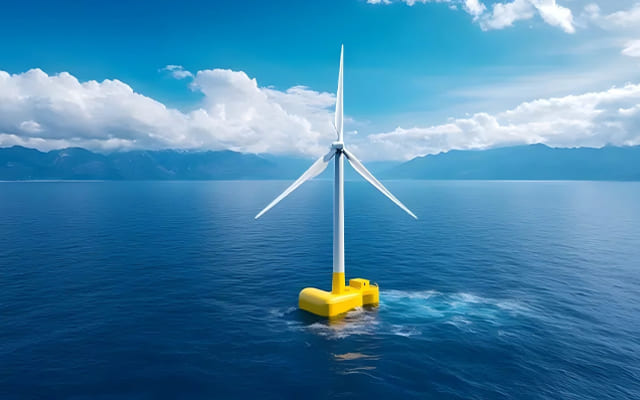Floating wind turbines have long been seen as the future of offshore wind power—especially in deep waters where traditional fixed-bottom foundations were considered impractical or too costly. But a new technology developed by U.S.-based Entrion Wind is making waves in the industry, offering a fixed-bottom alternative that works in water depths up to 100 meters. Could floating wind turbines lose their edge?
Why Floating Wind Turbines Became the Deepwater Standard
In offshore wind projects located far from shore, developers often deal with water depths beyond 50 meters. At these depths, floating wind turbines became the preferred solution. Their buoyant platforms, anchored by mooring lines, allow turbines to float above the seabed—making installation feasible without the need for deep foundation drilling.
Projects like China’s Three Gorges Lead, Fuyou, and CNOOC Guanyun wind farms have demonstrated the effectiveness of floating wind turbines in deep water, with installation depths reaching 65 to 120 meters. The average depth for floating wind farms globally continues to grow, showing strong support for this technology.
The main reason for their popularity? Floating wind turbines reduce the cost of building in deep water compared to traditional fixed-bottom solutions, which become more expensive and technically difficult as depth increases.
But this cost advantage may not last forever.
A New Fixed-Bottom Contender: Entrion Wind’s FRP Technology
Entrion Wind is developing a breakthrough known as the Fully Restrained Platform (FRP)—a fixed-bottom monopile foundation that can be used in water depths up to 100 meters. This is a major departure from industry norms, where monopiles are typically limited to shallower waters under 60 meters.
What Makes FRP Different?
Unlike floating wind turbines, FRP uses a single large-diameter monopile driven into the seabed. But it’s not a traditional monopile—it’s engineered for buoyancy control, vibration reduction, and fatigue resistance, allowing it to work where monopiles never could before.
Key features include:
-
Buoyant Monopile with Internal Air Chambers: Adjusts floatation during transport and installation.
-
Rigid Transition Piece: Improves fatigue life and supports the turbine tower with higher stiffness.
-
Dual Mooring Modes: Compatible with suction or pile anchors, offering flexibility across seabed types.
-
Top-Mounted Mooring Assembly (TMA): Increases natural frequency by 30%, reducing the risk of vibration damage over time.
Most importantly, Entrion Wind claims that FRP can reduce foundation costs by 15–20% compared to floating wind turbines in the same depth range.
Floating Wind Turbines vs Fixed-Bottom: A Cost and Performance Comparison
As offshore wind expands into deeper waters, developers are starting to compare floating wind turbines with advanced fixed-bottom alternatives like FRP. Here’s how they stack up:
| Feature | Floating Wind Turbines | FRP Fixed-Bottom Foundation |
|---|---|---|
| Suitable Depth | 50–150 meters | 60–100 meters |
| Stability | Subject to wave motion | Rigid and anchored |
| Installation | Requires dynamic positioning | Standard monopile process |
| Cost (80–100m depth) | Higher | 15–20% lower |
| O&M Access | Requires boats or helicopters | Easier tower access |
If FRP performs as promised, floating wind turbines may no longer be the default option for deepwater wind farms—especially in transitional zones between 60 and 100 meters.
From Concept to Certification: How FRP Earned Industry Validation
Entrion Wind began work on its FRP design in 2020. Over the past four years, the technology has gone through extensive testing and industry collaboration:
-
2020: Initial concept development and feasibility study.
-
2021: Site study off Massachusetts (35–85 meters depth) in partnership with InterMoor.
-
2022: Prototype testing in Norway with engineering partners EEW and Techano.
-
2023: Collaboration with Sif Group and selection for a ScotWind evaluation project.
-
2024: U.S. patent granted; feasibility certified by DNV.
The DNV feasibility statement confirms that FRP meets structural, material, and environmental standards, clearing the way for further development and deployment.
Floating Wind Turbines Still Lead—But for How Long?
There’s no doubt that floating have opened new frontiers for offshore wind power. They’ve made it possible to develop wind farms far offshore, in deeper waters, and in areas with uneven seabed terrain. However, they also come with unique challenges:
-
High installation and maintenance costs
-
Complex mooring systems
-
Greater sensitivity to wave motion and vibration
-
Longer installation times and limited port availability
As the offshore wind industry seeks to lower LCOE (Levelized Cost of Energy) and scale up production, any technology that simplifies installation and reduces lifecycle costs will be in high demand.
That’s where fixed-bottom FRP foundations offer new promise. By keeping the proven benefits of monopiles while expanding their usable depth, Entrion Wind’s FRP could make floating wind turbines less necessary in many locations.
Industry Momentum: Strategic Partnerships & Pilot Projects
Entrion Wind isn’t going it alone. In 2024, the company partnered with Simply Blue Group, a global offshore wind developer with over 10 GW of floating wind projects and 4 GW of fixed-bottom capacity.
Together, they’re evaluating FRP’s performance in 60–80 meter waters—a depth range traditionally dominated by floating wind turbines. The joint study focuses on engineering design, manufacturability, installation procedures, and long-term operations.
Commercial delivery of the FRP solution is targeted for 2026–2027, with full industry deployment possible within the decade.

